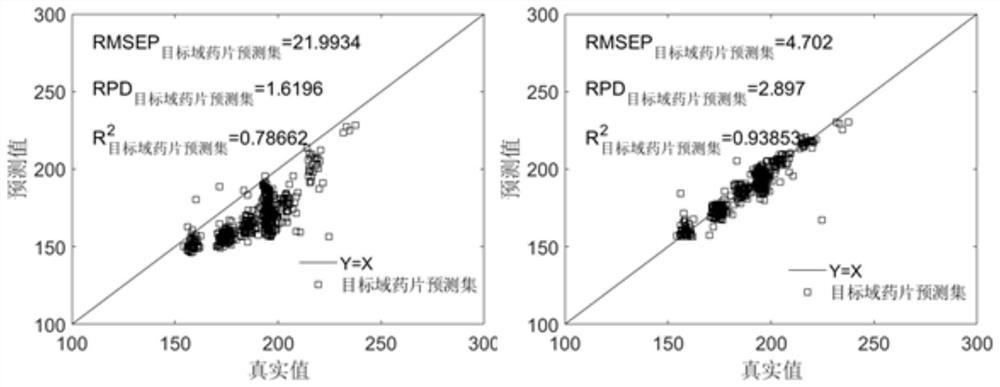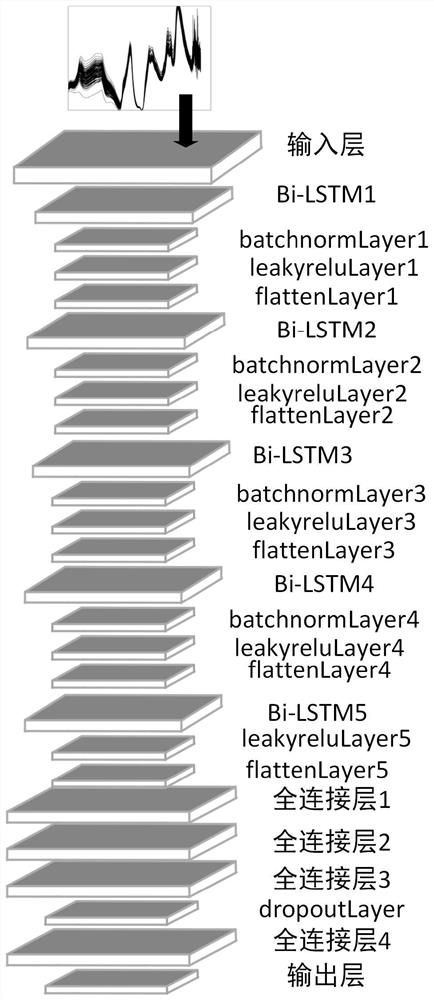Near-infrared spectrum model migration method based on deep Bi-LSTM network
A near-infrared spectroscopy and model technology, which is applied in the field of near-infrared model transfer, can solve problems such as model mismatch and model incompatibility between different samples, and save time.
- Summary
- Abstract
- Description
- Claims
- Application Information
AI Technical Summary
Problems solved by technology
Method used
Image
Examples
Embodiment 1
[0054] (1) Use the near-infrared spectrum data set of tablets published on the website of the International Conference on Diffuse Reflectance. The data set download website: (http: / / www.idrc-charmbersburg.org / shootout2002.html).
[0055] (2) Add Gaussian white noise with signal-to-noise ratios of 70DB and 80DB to the source-domain near-infrared spectral data respectively.
[0056] (3) Perform VMD (Variational Mode Decomposition) decomposition on all near-infrared spectra. The VMD algorithm formula continuously iteratively updates the mode, the corresponding center frequency and the Lagrangian multiplier until the correlation coefficient meets the conditions, stops the iteration, and outputs all IMFS , only extract the first sub-mode IMF1 of each spectrum; perform SNV (Standard normal variate) correction on all IMF1; normalize the corrected spectral data.
[0057] (4) Use the spxy algorithm to screen 920 spectra from the source domain calibration set, 80 spectra from the verifi...
Embodiment 2
[0070] (1) Dilute polyglutamic acid life liquid and energy liquid by 50% successively to obtain samples with concentrations of 3.5g / mL, 1.75g / mL, 0.875g / mL, 0.4375g / mL, and 0.21875g / mL liquid.
[0071] (2) The near-infrared spectra of all samples were collected by using the Bruker Fourier transform near-infrared spectrometer, and the near-infrared spectral data of the vital liquid were used as the source domain data, and the near-infrared spectral data of the energy liquid were used as the target domain data.
[0072] (3) In order to avoid overfitting of the trained neural network model, Gaussian white noise with signal-to-noise ratios of 70DB and 80DB was added to the collected vital fluid data.
[0073] (4) Perform VMD decomposition on all spectra, and only take IMF1; perform SNV correction on all IMF1; normalize the corrected spectral data.
[0074] (5) Use the spxy algorithm to divide the spectral data of life fluid and energy fluid into calibration set, verification set ...
PUM
 Login to View More
Login to View More Abstract
Description
Claims
Application Information
 Login to View More
Login to View More - R&D
- Intellectual Property
- Life Sciences
- Materials
- Tech Scout
- Unparalleled Data Quality
- Higher Quality Content
- 60% Fewer Hallucinations
Browse by: Latest US Patents, China's latest patents, Technical Efficacy Thesaurus, Application Domain, Technology Topic, Popular Technical Reports.
© 2025 PatSnap. All rights reserved.Legal|Privacy policy|Modern Slavery Act Transparency Statement|Sitemap|About US| Contact US: help@patsnap.com



